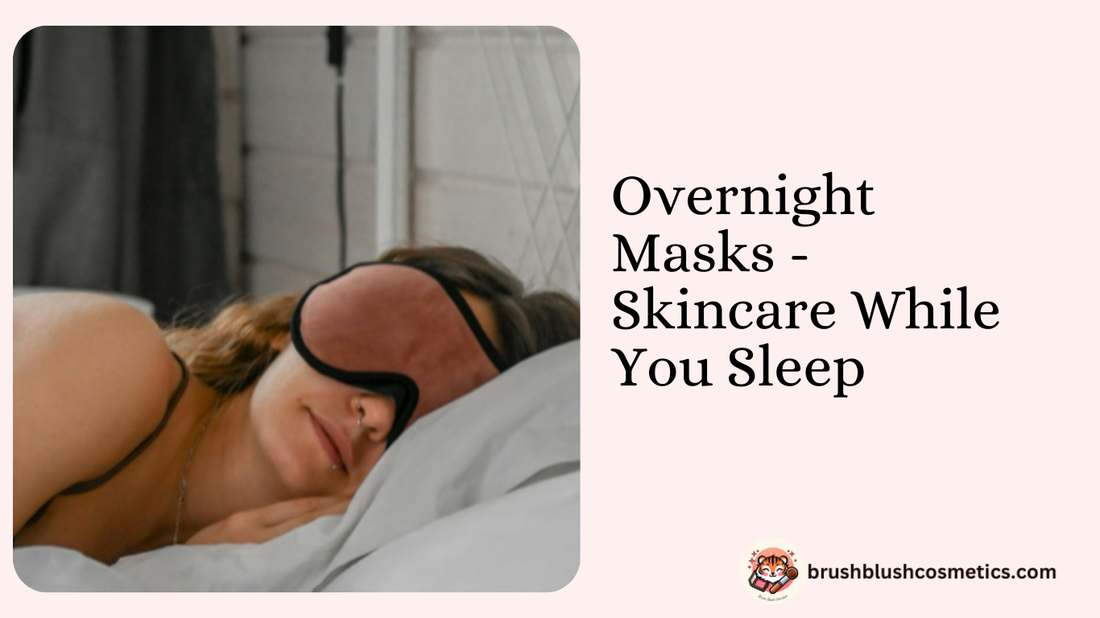
Рутините за грижа за кожата стават все по-скоро нощни , буквално. Една от най-големите сензации в грижата за кожата през 2025 г. е нощната маска за сън (наричана още „маска за сън“). Тези процедури – от гел маски до богати кремове и лист маски – се нанасят преди лягане и се оставят за една нощ, за да се събудите с по-влажна, „стъклена“ кожа. Всъщност интересът към нощните маски е експлодирал: търсенията в Google в САЩ за „нощна маска за лице“ скочиха с 672,5% на годишна база, водени от шума около TikTok и блогърите за грижа за кожата. Такива маски обещават да хидратират, възстановяват и съживяват кожата, докато спите . Те са привлекателни за заетите американци, които искат лесна, силно въздействаща рутина – просто нанесете маската след почистване и я оставете да действа през цялата нощ. Дерматолозите отбелязват, че тези продукти могат да помогнат на кожата да „привлича и задържа влагата“, превръщайки една проста стъпка в грижата за кожата в дълбок хидратиращ тласък.
Защо нощните маски са на мода
Тенденцията отразява по-голяма промяна към лесна, високоефективна грижа за кожата . Потребителите обичат идеята да се събуждат със сияние с минимални усилия. Както отбелязва лаборатория за красота, нощните маски са се превърнали в „задължително нещо“, за да оптимизирате рутината си, докато спите . Те са съобразени с нашия забързан начин на живот и културата на TikTok: вирусни видеа показват инфлуенсъри, носещи платнена маска (например Biodance Collagen Mask на K-beauty) и се събуждат с видимо по-плътна, хидратирана кожа. Резултатът? Тези маски буквално се разпродават: една нощна колагенова маска стана вирусна и се превърна в най-продаваната маска за лице на Amazon в края на 2024 г. Накратко, нощните маски са хит, защото обещават големи резултати (сияйна, гладка като бебе кожа) почти без усилия – само сън!

Как работят нощните маски
Нощните маски действат, като създават оклузивна бариера и заключват активните съставки дългосрочно. За разлика от маските за бързо отмиване, маските за сън остават върху кожата с часове, позволявайки на съставките да проникнат по-дълбоко. Експертите по красота обясняват, че когато оставите хиалуроновата киселина, пептидите или ретинола върху кожата си за една нощ, тези активни съставки имат повече време да действат с пълна сила . Както казва един блогър за грижа за кожата, оставянето на продукта по-дълго означава, че активните съставки могат „дълбоко да проникнат в кожата ви, увеличавайки максимално ползите си“. На практика, нощната маска действа като високотехнологичен овлажнител: тя се прилепва към лицето ви, запечатва влагата и може да съдържа съставки (като колаген, витамин С или ниацинамид), предназначени да запълнят, озарят или възстановят. До сутринта кожата е добре хидратирана и освежена. Важно е, че тези маски не стоят просто бездействащи. Списание Glamour отбелязва, че една наистина ефективна нощна маска „не просто стои върху кожата; тя помага на кожата да привлича и задържа влагата “. Много от тях са формулирани като леки гелове (напр. Laneige Water Sleeping Mask), които попиват бързо, без да омазняват. След нанасяне, оклузивният слой на маската предотвратява загубата на вода през нощта, така че естествените ви процеси на заздравяване и хидратация протичат необезпокоявано. По същество, вие давате на кожата си непрекъснато време да абсорбира хидратиращи съставки и хранителни вещества – това е като мини спа процедура, докато сънувате.
За кого е най-подходящо
Нощните маски са особено подходящи за хора със суха или дехидратирана кожа , които се нуждаят от допълнителна влага, или за тези, които живеят в студен или сух климат. Дерматолозите ги препоръчват на всеки, който иска да се „събуди с по-сияен и сияен тен“. Тъй като много от най-добрите продукти имат формули на гел или водна основа, те са склонни да се абсорбират добре, без да се усещат твърде тежки, което ги прави подходящи за повечето типове кожа . Например, д-р Дара Спиърман (сертифициран дерматолог), хвали леката гел текстура на популярната маска за сън и казва, че тя работи добре за всички типове кожа – особено за тези, изложени на сурово време или умора от пътуване. Въпреки това, нощните маски не са универсални. Ако имате много мазна, склонна към акне кожа, тежък оклузивен крем може да запуши порите. Ако сте чувствителни, маска със силни активни съставки (като високопроцентен ретинол или AHA) може да е твърде много за една нощ. Като общо правило: използвайте хидратиращи маски (със съставки като хиалуронова киселина, керамиди, сквалан) за ежедневна хидратация и резервирайте маски с мощни активни съставки (като киселини, витамин C или ретинол) 1-2 пъти седмично, за да избегнат раздразнение. Хората с умерено до тежко акне или много реактивна кожа трябва да тестват внимателно – започнете с нежни формули и кратко време за нанасяне.
Как да използвате безопасно нощни маски
За да включите нощна маска в рутината си, следвайте тези стъпки за начинаещи:
- Първо почистете. Винаги започвайте с чисто лице. Отстранете грима и измийте лицето си с обичайния си почистващ препарат. Подсушете с потупване.
- Тонизирайте или се погрижете за кожата. Ако използвате тоник или серум (напр. хидратиращ тоник или лек ретиноид), нанесете го и го оставете да попие. Маската трябва да е последната стъпка от вашата вечерна рутина (след серуми, но преди слънцезащитен крем на следващия ден).
- Нанесете маската. Нанесете равномерно маската за сън върху лицето (и шията, ако желаете). Лист маските са прости: просто ги разгънете и поставете върху кожата. Крем/гел маските могат да се предлагат в бурканчета или тубички.
- Следвайте инструкциите. Някои маски за сън препоръчват да се оставят за една нощ; други казват минимум 2-3 часа. Прочетете етикета. Можете да спите с нея (много потребители правят това) или да я изплакнете сутрин.
- Честота: Използвайте маски за сън 1-3 пъти седмично, за да подобрите хидратацията. Можете да използвате нежни хидратиращи маски всяка вечер през сухите зимни месеци, но ограничете по-силните активни съставки. Както съветва един дерматолог: „Хидратиращите маски могат да се използват ежедневно... Ексфолиращите или маските против стареене трябва да се ограничат до 1-2 пъти седмично“.
- Измийте лицето си или го изплакнете с топла кърпа сутрин. На сутринта или изплакнете лицето си с вода, или отстранете остатъците с топла, влажна кърпа. След това продължете с обичайната си сутрешна рутина и слънцезащитния крем. Не забравяйте SPF – дори най-добрата нощна маска няма да предпази от дневното слънце.

Съвети, трикове и погрешни схващания
Максимални резултати: За допълнителен ефект някои хора първо съхраняват гел маските за сън в хладилник за охлаждащ ефект или нанасят двойна маска (напр. лист маска на лицето и гел маска на ръцете). Можете също така да нанесете богата маска на пластове и да я покриете с чисто фолио или кърпа, за да избегнете залепването на чаршафите за възглавниците. Ако маската ви е много хидратираща, след това нанесете лек слой от обичайния си нощен крем или масло за лице, за да запечатате всичко. Митове и предупреждения: Един мит е, че тези маски инжектират колаген в кожата. В действителност колагенът в локалните маски работи предимно на повърхността (хидратира и изглажда повърхностно), а не изгражда вашия собствен колаген дълбоко в кожата. Мислете за това като за тласък на хидратацията и по-гладък вид на кожата, а не за постоянно решение. Също така, маските с мощни съставки (като киселини или витамин А) могат да раздразнят, ако се оставят цяла нощ. Винаги тествайте нови продукти върху малка част от кожата. Ако забележите зачервяване или парене, незабавно отстранете маската. Повече не е винаги по-добре: Оставянето на силна ексфолираща маска за една нощ може да прекали. Правилото на дерматолозите е да се избягва продължително носене с активни маски. Също така, въпреки че тези маски хидратират, те не заместват ежедневните овлажнители или слънцезащитни продукти – все пак се нуждаете от балансирана рутина. Съвет от експерти: Търсете ключови думи като „Маска за сън“ или „Маска за нощ“ на етикетите на продуктите. Корейските марки (Laneige, Innisfree и др.) популяризираха категорията, но много марки от дрогерии и универсални магазини вече ги предлагат. Включвайте маската си в нощите, когато се нуждаете от тласък на хидратацията – например след ексфолираща терапия или когато кожата ви е изключително суха.
Примерна рутина и предложения за продукти
За да обобщим всичко, ето един прост пример за седмична рутина за сух или нормален тип кожа:
- Нощ 1: Нежно почистващо средство → хидратиращ тоник/есенция → хидратираща нощна маска (напр. Laneige Water Sleeping Mask) → заключете с леко масло (по избор) → сън.
- Сутрин: Изплакнете, нанесете слънцезащитен крем и хидратиращ крем през деня, както обикновено.
- Нощ 2: Почистващ продукт → серум (напр. ретинол или витамин C, ако кожата ви го понася добре) → антиоксидантна или възстановяваща маска за сън (напр. гел маска с витамини) → сън.
- Нощ 3: Почистващ продукт → маска за сън , нанесена само върху кожата (за максимална хидратация) → сън.
- Нощ 4: Повторете Нощ 1 или използвайте маска за лице (като колагеновата маска за лице Biodance, която стана вирусна) за 20-30 минути преди лягане (не е необходимо да оставяте листа цяла нощ, освен ако не е посочено друго).
- Останалата част от седмицата: Използвайте обичайния си нощен овлажнител през нощта, когато не слагате маска.
За идеи за продукти, потърсете всяка „маска за сън“, която отговаря на вашите нужди:
- За допълнителна хидратация: Kiehl's Ultra Facial Overnight Hydrating Mask или Clinique Moisture Surge Overnight Mask.
- За по-плътна кожа: лист маски с колаген или хиалуронова киселина (като хидрогелните маски на BEAUTYBAY).
- За успокояване/зачервяване: маски с керамиди или ниацинамид.
Също така, поддържайте кожата си отвътре: пийте много вода, помислете за овлажнител в спалнята си и се наспявайте добре. Здравословните навици ще направят нощната ви маска още по-ефективна.
До 2025 г. маските за сън доказват, че са нещо повече от трик. С мощен онлайн шум и истинска наука за съставките, те наистина могат да дадат тласък на вашата рутина – особено ако имате нужда от допълнителна хидратация. Просто ги използвайте разумно (ограничете силните активни съставки, тествайте върху малка част от кожата и хидратирайте по подходящ начин) и можете да се събудите с по-щастлива и по-плътна кожа. Очакват ви сладки сънища и още по-сладка кожа!
